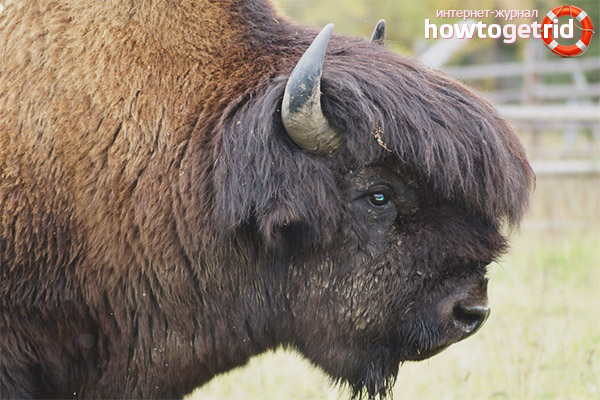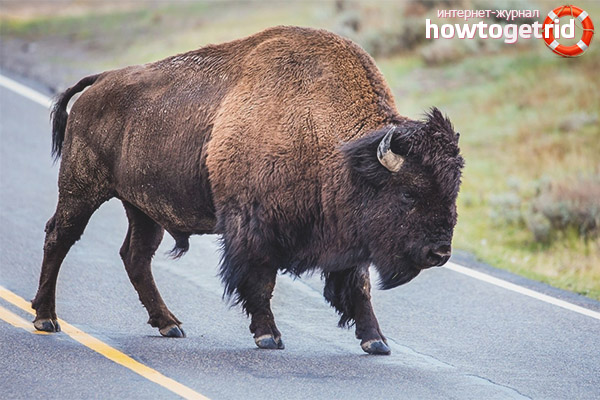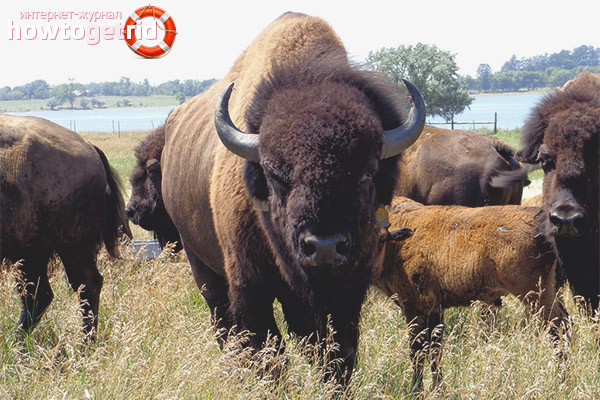The content of the article
Bison (Bisonbison) - a cloven-hoofed mammal belonging to the bovine family. This animal is one of the largest inhabiting the territory of North America.
On the brink of doom
By the time colonizers colonized North America, the number of bison on this continent was about 60 million individuals. Separate herds totaled up to 20-30 thousand animals. The indigenous inhabitants of these lands - the Indians - hunted buffalo solely to meet basic needs:
- for food;
- making clothes;
- providing the tribe with weapons that served as horns and bones;
- the skin of a bison was used to shelter a home.
This is not to say that the livelihoods of the Indians greatly influenced the number of these artiodactyls. But with the advent of immigrants from Europe to the mainland, a rapid and sharp decline in bison populations in North America begins. Their murder was turned into a fun by the colonialists, and with the outbreak of the commercial and industrial revolution in Europe, the extermination of animals was put on stream. Destruction was carried out by both white hunters and Indians, who in return were promised firearms, whiskey, knives, gunpowder. The skin of bison and their meat was in demand at that time. The main reason for the massacre was the desire to deprive the indigenous population of the foundations of existence, and, as a result, lead the Indians to starvation.
As a result of bloody atrocities, by the beginning of the XX century in the New World there were about 800 animals. In 1907, the government made the first attempts to save the endangered species: reserves and national parks were created, laws were passed prohibiting unauthorized shooting. These measures allowed to increase the number to several tens of thousands of goals.
Bison subspecies
- forest;
- steppe.
Forest bison are larger than the steppe relatives. A distinctive feature of the steppe is the presence of a throat, located directly under the chin. In a forest bison, this organ has not reached final development.
Habitat
The habitat of these artiodactyl mammals is strictly defined by the boundaries of the National Parks. Now they live in Canada and the northern borders of the United States.
On the territory of Russia in the wild bison are not found. In 2006, the Canadian authorities donated 30 forest bison to the Ust-Buotama nursery (Republic of Sakha) - this species is listed in the Red Book. The nursery plans to revive the forest buffalo population in the Russian Federation.
Appearance

Bison are one of the largest mammals in North America. The body has a massive structure and reaches a length of 3 meters. Broad shoulders and low hips are characteristic of the animal. The height at the withers is up to 2 meters due to the hump, the length of the vertebrae in which is 30-33 cm. The legs are low, but strong and dense due to the large number of muscles. Adult males weigh more than a ton. Females are more modest - 700-800 kg.
The animal has a powerful wide forehead, short hollow horns, a low-set head with small black barely noticeable eyes. The body of the animal is covered with thick dark dark brown hair. On the head, shoulders and chest, the hairline is longer, on the chin it resembles a beard. The wool on the front of the case grows to 50 cm. The pile on the back is shorter.
The coat has a brown color, sometimes brown. There are individuals of black-brown color. The cubs are born light brown or red, then the color of the pile darkens, the hair is made more stiff.
Habits and lifestyle
Bison live in herds, which number several thousand animals. The top of the hierarchy belongs to several large males, constantly defending their leading positions in the course of numerous fights. Females with cubs and other males often form separate herds.
The bison have a well-developed vision and sense of smell. They are able to smell a stranger who is several kilometers away. Bison are generally calm animals, but, sensing danger, they quickly go on the offensive. When attacking a herd of wolves or coyotes, adults protect the young, driving away predators with their powerful horns and hooves. As a rule, wolves attack calves, trying to take them away from the female and relatives. In the summer months, strong and well-fed animals give a worthy rebuff to attackers. Despite their impressive size, the bison are agile and quick. If necessary, they can gallop at a speed of 50 km / h, i.e. equal to the speed of the horse, and to overcome vertical obstacles with a height of more than 1.5 m. In winter, the bison are weakened by a lack of food, low temperatures, snow drifts, which are difficult to get through. This gives predators many opportunities for a successful outcome of the attack.
Huge animals swim great. This ability is necessary for them during movements to new pastures. In summer, they easily cross rivers. In winter, and especially in springtime, crossing over frozen rivers is fraught with great danger. Ice in some areas does not support the weight of the animal. A beast caught in ice water is doomed to death.
What do bison eat
Bison are herbivores. During the summer plenty, their diet is made up of grassy meadow grasses, some species eat leaves of trees, branches of shrubs and young shoots. In winter, they feed on moss and lichen. They find food under snowdrifts up to 1 meter deep, with the help of their massive muzzle, digging up snow.
In summer, animals are gaining weight. The daily intake of vegetation is 23-25 kg. Food enters one of the chambers of the stomach, where cellulose breaks down under the influence of enzymes. Then they burp a mash, after which they carefully chew again. Food then passes through the other three sections of the stomach, where the digestion process continues, and enters the intestines.
Breeding and raising offspring
From May to September, the bison season begins in bison. This is a hot time for males, in the herd the bloody battles for the location of the female do not stop. Skirmishes sometimes end in mortal wounds. Marital fights are always accompanied by a low dense roar, which can be heard at a distance of 8 km in calm weather. During the breeding season, the herd breaks up. Females with one-year-old calves and males graze separately. In the autumn, after the end of the “weddings” period, the herd reunites.
Dominant males will fertilize several females, collecting harems, but the choice of a decent one is still up to the female. Having won the battle, the bull is not always to his taste, and the female runs away from him. Bulls can walk for a flowing female for about a week, until she “melts”. After intercourse, the duration of which does not exceed 20 seconds, the bull is still for some time next to the female, then goes in search of a new passion.
The first few months, the calf feeds on mother’s milk and quickly gains weight, gaining a mass of 300 kg by the year. Young growth is always under the supervision of adults, because playful and careless calves are easy prey for predators. Another danger to the young is harsh winter. Not having time to grow stronger and gain enough fat, individuals do not survive in severe frosts. According to statistics cited by Yellowstone National Park employees, half of the cubs in the herd do not live to be one year old.
Bison reach puberty at 4 years old. Males are especially vulnerable at this time - they still cannot compete with older and stronger individuals, and often get serious injuries in fights. In the wild, animals have an average lifespan of 20 years. In captivity, some individuals live up to 25 years.
Video: Bison (Bison bison)











Submit